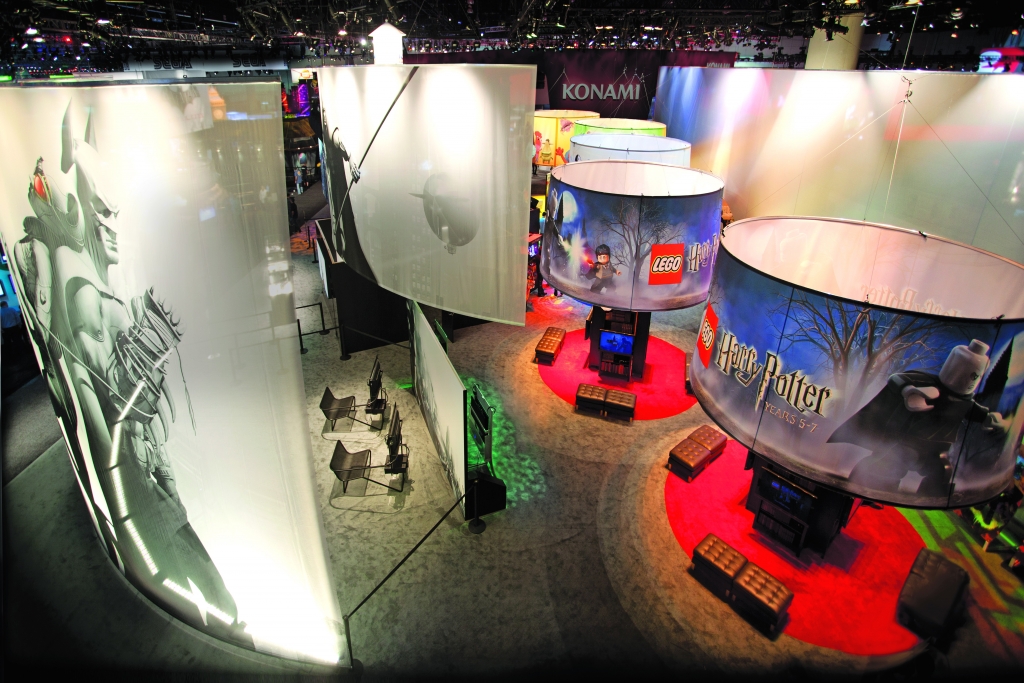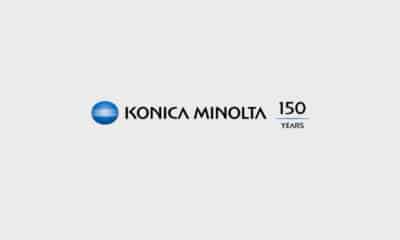“Our focus has always been to print on fabric, or fabric-like material,” says Olle Lindqvist, president of the US sales office of Big Image Systems, the 25-year-old company headquartered in Sweden. “That’s where we started, where we have the skills, and where we can offer something unique.” By his estimation, the company has printed on more than 2000 fabrics and flexible media since its founding, and it continually tests new material.
Big Image Systems’ prints have been seen on curtains and carpets, furniture and buildings, and walls and ceilings. The company is primarily known, however, for its output of gargantuan images on fabric, which transform a stage, exhibit hall, or retail space into a new environment with new possibilities.
In one of its largest projects to date, the company produced a 38,000-square-foot recreation of Mt. Everest to commemorate the 50th anniversary of the conquest of the world’s highest peak. Installed a few years ago inside a former gas storage tank in Leipzig, Germany, this cyclorama immersed visitors in an image that stood 110 feet high and measured 345 feet in circumference. Printed on more than 50 sections of uncoated muslin, the final output weighed in at nearly a ton when assembled for installation.
And every year continues to bring new projects that serve to further bolster Big Image Systems’ reputation as the go-to company for fabric printing on the grandest scale. For the 2011 E3 Expo electronic-gaming conference in Los Angeles, for instance, the company provided EventMakers, an event-production specialist firm, with a variety of graphics printed on voile sheer cloth, flag cloth, and Artist Heavy polyester for the Warner Bros. booth. Highlighting characters such as Batman, Harry Potter, and the Sesame Street cast, the largest graphic was a dye-sub print on flag cloth measuring 24 x 90 feet. The project also required two more pieces on flag cloth measuring 15 x 40 feet, a 24 x 47-foot panel on voile, and five tapered cylinders (each measuring 27 x 50 feet) output on Artist Heavy polyester. The shop also designed and engineered the frame system to suspend and support the prints.
For last year’s Association of Fundraising Professionals conference in Chicago, Lindqvist and his staff worked with event planner Leading Authorities on set design and production, with all work printed on fabric. In keeping with the event theme, “Fundraisers are Story Tellers,” they collaborated on a 35-foot stage backdrop designed to represent an open book. Keynote speakers – including former president Bill Clinton – entered the stage through a cutout in that polyester curtain, stepping out of the book’s pages to share their stories.
“Printing is the most straightforward part of many of these projects,” notes Lindqvist. “But we can also advise clients on the artwork, the best fabric, even the packaging as well as the installation. We have a lot of capabilities in house.”
Advertisement
Utilizing, and creating, technology
For Big Image Systems, “in-house” means either of two production facilities in Europe: one in Taby, outside Stockholm, and another near Berlin. Together, the European operations employ more than 60 people. The American sales office functions as contact point for clients here, and is staffed by Lindqvist as well as an account executive and an artwork/production manager.
Throughout Europe, the comapny is a recognized specialist in printing on fabric and flexible materials for the theater, corporate, and retail markets. Here in the States, business is divided between clients in the entertainment industry and corporate events.
“Many of our US clients come to us initially because they are looking for something beyond what their current large-format print provider can handle due to size or complexity,” notes Lindqvist. He estimates US sales around $2 million in 2011.
To meet clients’ varied demand, the company has a mix of the latest in wide- and grand-format presses at its European facilities. Which printer gets used depends on the usual mix of factors, including size of the job, as well as material required. As Lindqvist explains, the company’s Gandinnovations AquaJet (now Agfa) dye-sub printer can handle rollfed polyesters up to 10-feet wide. Two Durst Rho 350 UV printers are used for printing backlit images on polyesters and foil projection screens. For polyesters up to 16-foot wide, and for grand-format vinyl, the company’s EFI Vutek UltraVu 5300 handles the job. Finishing is handled with Zünd 10-foot-wide cutting machines.
For most shops, that hardware roster might seem like a pretty comprehensive printer lineup. But it’s only part of the picture at Big Image. As a pioneer in digital printing on fabric, the company has also designed and developed its own print systems, pushing the definition of grand-format printing to its limits.
When photographer and company founder Werner Schäfer first encountered large-format printing while on assignment in Australia in 1981, he immediately recognized its potential appeal. Early on, though, he believed digital printing on fabric, rather than paper or other rigid substrates, could be a superior solution for some applications and settings. Flexible images, he reasoned, could be easily installed and removed, and re-used again and again without damaging the print.
Advertisement
Schafer introduced digital large-format graphics to many in his market area while working as the Scandinavian sales rep for a Liverpool-based printer. Success there only strengthened his conviction, and eventually Schafer set out on to pursue his vision of printing on fabric. He purchased an early digital airbrush printer in 1987, launching the company that became Big Image as ScanaPrint AB. When that press proved too complicated to reliably deliver consistent, he decided to design and build his own fabric press.
Working with students at Sweden’s Royal Institute of Technology, Schafer designed and developed the digital Airbrush printer, which now allows Big Image to print seamless images on fabric at sizes few companies can approach, Big Image Systems reports. Key to its performance is the Airbrush printer’s large drum design. Fabric is taped to the drum, which slowly rotates beneath the printhead during printing.
“The ink is applied by four spray nozzles in a vertical row, spraying out all four colors at the same time on top of each other,” explains Lindqvist. “The print is actually a spiral, with each line only a few millimeters apart.” Big Image Systems has three of these Airbrush fabric printers, which use water-based inks. Two presses can print images on fabric up to 20 x 20-feet; the third unit can image up to 20 x 40-feet.
“We use our Airbrush printer almost exclusively for the theater work,” he continues. “We print on the same materials these clients have been using for their set designs – muslin, velour, scrim, and PVC foil – to create a seamless image.”
Another advantage, he says, is the fact these materials require no special handling to preserve and protect the print. Fabric can be folded up, rolled, packed away, and re-used without damage. “That’s the durability they need and expect,” he says.
In fact, the drum design worked so well for its Airbrush printer that Schafer later adapted it to inkjet with the company’s other proprietary press, the BopJet. This machine is used to print on specialty fabric up to 16-feet wide.
Advertisement
“The drum puts less stress and tension on the fabric during printing so we can print on fabrics that are not strong enough for a conventional printer,” says Lindqvist. “There are a number of fabrics that work only or best on the Bopjet: Cloth 201 muslin, sheer fabrics like voile, and PVC flooring, which is fairly stretchy.”
All the world’s a stage
As word of the company’s capabilities spread, clients throughout Europe turned to the company as a large-format solutions provider. The theater community, especially, learned how to tap imaging on fabric as a superior solution for stage and set design.
“Theaters were used to working with craftspeople in scene shops, and not with print shops,” notes Lindqvist. “To become their supplier, Big Image had to develop an understanding of how the images were used, and master craft skills like theatrical sewing and edge finishing.”
Demand from that sector eventually proved so great that Schafer added the Berlin operations center in 1995. Then, in 1998, he relocated the Swedish production center to a former aircraft hanger outside Stockholm, which now serves as the company’s headquarters.
By the time the American sales office opened in 2001, Big Images already had a following within the American theater community, too. “We had been selling to clients in the US prior to 2001, and saw an opportunity here,” recalls Lindqvist. “We had a strong reputation in the theater world for grand-format printing on fabric. Soon people on the corporate event side heard of us, as well.”
The American office now serves a client base that is half theater and entertainment, and half corporate events. “Some know what they want, and turn to us simply to print their files,” he notes. “Others need our help from start to finish, figuring out what will work best, what fabrics to use, and how to handle the installations.”
The typical project, if there is such a thing, requires three or four hours of print production time, two days shipping to the US, and relies heavily on online tools to get the jobs done. “Without the Internet we couldn’t operate,” notes Lindqvist. “It’s involved in every aspect of our jobs – from initial contact through transferring files. There are all kinds of communications back and forth, a lot of e-mail, even occasional video conferencing, to make sure our clients get exactly what they need for their job.”
Often, Big Images is brought on as a subcontractor for the end user. In theater, the company regularly provides prints for Rosebrand and iWeiss, both specialists in stage design production. “When we work directly with theater clients, we’re more involved in selecting the fabric and deciding on the quality of the image.”
On the corporate side, its working partners include such event specialists as Momentum, Ovation, Eventmaker, and Extraordinary Event. “There are other companies who can do large-format printing on the corporate side, of course, but we have much more experience with printing on fabric – to them new options,” in transforming a conference center or exhibit hall.
For the corporate clients, timing is everything: “There really is no margin for error,” he points out. “Our clients often receive their print only a day or two before an event, and many times do not even have time to look at the print before they begin the installation.”
Meeting those expectations puts Big Image in its own niche. “Our customers know we print on all types of fabric, are very strong in color management, and put a lot of effort into customer service, to make sure they are completely happy with the work we do.”
Retail: the third column
As Big Image Systems looks to grow beyond the corporate and entertainment markets, Lindqvist hopes to repeat the company’s growth in Europe, where retail now represents the third column in its success
“Overall, we’ve found the American market to be very similar to Europe, with a lot of clients learning the advantages of printing on fabric,” he observes. “But in Europe, retailers have been quicker to use our capabilities just like they are used in theater, to create a unique environment and exciting experience for shoppers. That’s something we hope to be doing for more clients here in the future.”
Freelance writer Mike Antoniak is a regular contributor to The Big Picture magazine.
Big Image Systems
www.bigimagesystems.com


 Blue Print4 weeks ago
Blue Print4 weeks ago
 Buzz Session4 weeks ago
Buzz Session4 weeks ago
 Beyond Décor: Rachel Nunziata2 weeks ago
Beyond Décor: Rachel Nunziata2 weeks ago
 Press Releases2 months ago
Press Releases2 months ago
 Press Releases1 month ago
Press Releases1 month ago
 Press Releases2 months ago
Press Releases2 months ago
 Press Releases1 month ago
Press Releases1 month ago
 Press Releases2 months ago
Press Releases2 months ago













